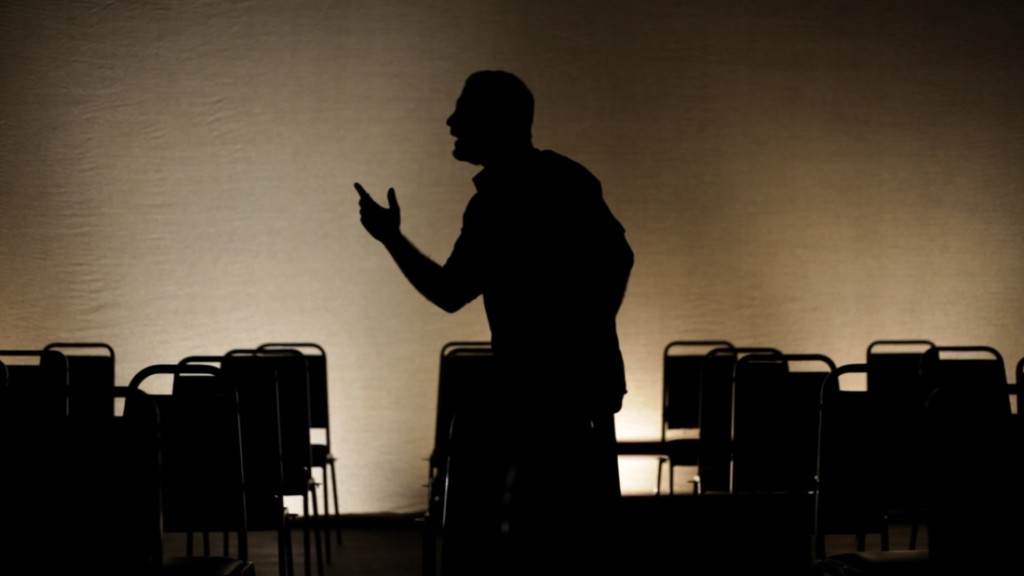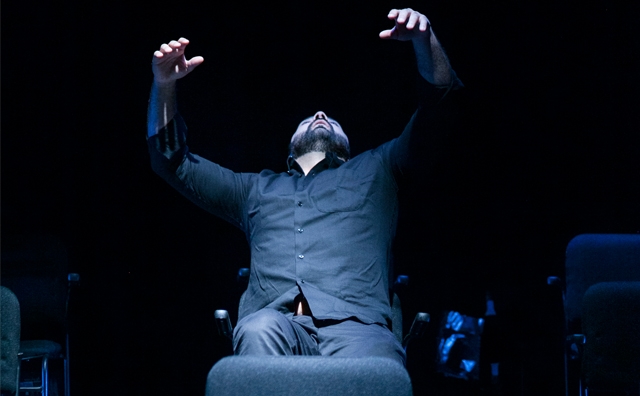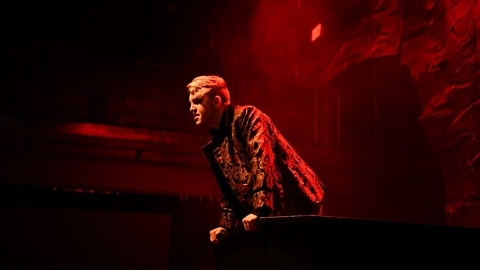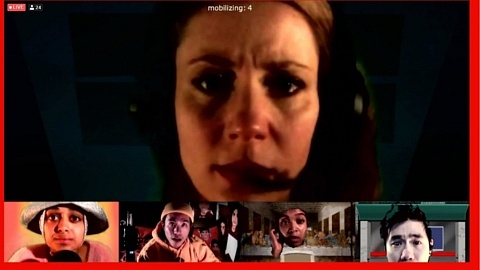For nearly two years, theatre lovers have felt entrapped in their own little purgatories. Artists have been unable to perform on stages, and audiences been...
DARTcritics on Mani Soleymanlou’s One
On Friday, 25 October, the DARTcritics attended the production One, from Montréal’s Orange Noyée productions, at the Brock Centre for the Arts. Here is a selection of their critical responses:
Sarah Lawrence writes: Darkness. Silence. Anticipation. Suddenly, a shadowy figure darts across the stage, and all at once the lights illuminate Mani Soleymanlou, out of breath and asking for a chance to restart. This is where our journey begins.
One is about Soleymanlou’s international voyage, beginning from his birth in Iran, to Paris, Toronto, Ottawa and finally Montreal where this one-man play was composed. Through it all Soleymanlou questions his identity by recounting life experiences that helped shape who he is.
With the aid of innovative lighting by Erwann Bernard, Soleymanlou’s larger than life personality, coupled with his animated body language and precise, shifting diction as he portrays different people, including himself at a younger age, transform the chairs on stage from a schoolyard, to a particular night on his grandmother’s balcony in Iran. Some chairs even become family members or imaginary citizens of Iran. Although Soleymanlou explicitly tells us who or what the chairs represent at that moment, it is left to the viewer to construct those representations based on knowledge of the subject matter. Thus, this play is substantially engaging because it directly interacts with the imagination.
 The lack of another human presence on stage allows Soleymanlou to evoke a sense of emptiness that forces him to delve beyond his surface identity and into the hard questions surrounding the constitution of his personality altogether. The attractiveness of this play is its focus on a theme that everyone can relate to. In a society so focused on the presentation of self through websites such as Facebook, Twitter and Instagram the need to establish a concrete sense of self becomes increasingly important… or does it? According to Soleymanlou, it doesn’t. The process of forming an identity is so complex and never-ending that to conceive of one that is unchanging, and then have to articulate it to others, is impossible.
The lack of another human presence on stage allows Soleymanlou to evoke a sense of emptiness that forces him to delve beyond his surface identity and into the hard questions surrounding the constitution of his personality altogether. The attractiveness of this play is its focus on a theme that everyone can relate to. In a society so focused on the presentation of self through websites such as Facebook, Twitter and Instagram the need to establish a concrete sense of self becomes increasingly important… or does it? According to Soleymanlou, it doesn’t. The process of forming an identity is so complex and never-ending that to conceive of one that is unchanging, and then have to articulate it to others, is impossible.
Soleymanlou’s direct interaction with audience members integrates the spectators into his performance. His lighthearted remark, “Oh! You should have answered that!” when an audience member’s phone goes off during the performance demonstrates not only self-confidence, but also an awareness of his surroundings, which makes his performance unique every time it is staged.
In the school bathroom in Paris Soleymanlou is Iranian. In the Toronto schoolyard he is French. And finally in Montréal he is deemed Québécois. All of these conflicting descriptions are insufficient in encompassing Soleymanlou’s complicated character and multi-layered life experiences, and so, for Soleymanlou, it begs the question: how can I possibly define myself?
Misha Harding writes: Thirty-five empty chairs set the stage, and Mani Soleymanlou’s powerful presence fills them all.
One is an autobiographical one-man show that explores Soleymanlou’s cultural identity, as he struggles to realize who he is, how to define himself — but more importantly, whether such definitions are even possible or necessary.
Soleymanlou invites the audience to join him as he recalls his childhood and adolescence. Born in an Iran he hardly remembers, he moved to Paris after the Islamic Revolution in 1979, where he learned to speak French, now his primary language, and was introduced to a new culture via which he was able to define himself. He then moved to Toronto, where he attended a French school that had 250 students from 82 different nations. His few years in Ottawa he dismisses quickly with a stammer, a wave of the hand, and a laugh from the audience.
It wasn’t until his move to Montreal that the questions that form One began to surface. Here he was continually asked, “Where are you from?”, never something he had to consider before. All of a sudden, he began questioning his origins, and how to define his own identity. He struggled, and still struggles, to associate with the labels that are assigned to him, and also has trouble trying to create his own.
The show itself sets up a comfortable, laid-back atmosphere, creating a relationship between audience and actor before Soleymanlou is even seen. Instead of an anonymous pre-show cellphone announcement, we hear Soleymanlou telling us that frankly, he doesn’t care if we turn them off, as we should make use of cheap evening rates.
A spotlight then comes up on the performer… in the wrong position. He tells the lighting technician that he was not ready, and that he must start again. This happens numerous times, and as the audience laughs, they begin to relax, and engage with Soleymanlou, ready to listen to whatever he has to tell them.
It isn’t until later that Soleymanlou hits the audience with more thought-provoking material. He describes his memories of Iran – of watching his mother change at the airport from her regular Western clothes to black clothing that covers her from head to toe. He describes the protests and riots that emerged from the 2009 Iranian presidential election, and the numerous deaths of young people who took to the streets, simply hoping for their country to be better. These images he creates are made painfully clear and real when he takes a cell phone out of his pocket, the lights go black, and he watches a video of these horrific riots that the audience can only hear.
The emotional tone of the show is perfectly balanced: the comedy is interrupted by dramatic moments, and the drama is broken by comedic turns.
The empty chairs are Solymanlou’s only set, and it works beautifully. The chairs help create every scene that he describes, from childhood classrooms to dramatic Persian rallies. They even fill in the roles of other characters from his life, making the audience momentarily forget that they are watching only one man.
In One, Soleymanlou works through who he is, and we in turn reflect on our own identity. He is absolutely compelling, creating clear images with his words. The lighting, designed by Erwann Bernard, helps to add to the atmosphere, but it is ultimately Soleymanlou that captures the audience’s attention, and holds it firmly from start to finish.
Related Posts
Rick Roberts’ Orestes, directed by Richard Rose, confronts the progressively blurring lines between real life and virtual life in a heightened version of the...
Every year the University of Windsor School of Dramatic Art produces multiple plays featuring its fourth-year students. This year, under the circumstances of...
Rick Roberts’ Orestes, directed by Richard Rose, confronts the progressively blurring lines between real life and virtual life in a heightened version of the...
Every year the University of Windsor School of Dramatic Art produces multiple plays featuring its fourth-year students. This year, under the circumstances of...
Leave a Reply (Cancel Reply)
Twitter Feed
Blogroll
DARTcritics.com is partially funded by the Marilyn I. Walker School of Fine and Performing Arts, in support of student learning; experiential education; student professionalization; public engagement with the teaching, learning and production activities of the Department of Dramatic Arts; new ways of thinking; and the nurturing of links with our communities.







